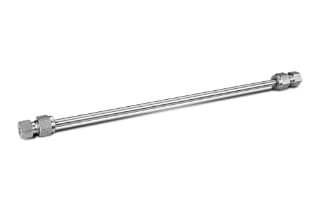
|
Chemistry |
Cyano (CN) |
|
Separation Mode |
Normal-Phase |
|
Particle Substrate |
Silica |
|
pH Range Min |
2 pH |
|
pH Range Max |
8 pH |
|
Maximum Pressure |
6000 psi (415 Bar) |
|
Endcapped |
No |
|
Silanol Activity |
High |
|
Particle Shape |
Spherical |
|
Particle Size |
5 µm |
|
Endfitting Type |
Parker-style |
|
Pore Size |
80 Å |
|
Format |
Column |
|
Surface Area |
220 |
|
System |
HPLC |
|
USP Classification |
L10 |
|
Inner Diameter |
4.6 mm |
|
Length |
250 mm |
|
Carbon Load |
3 % |
|
UNSPSC |
41115709 |
|
Brand |
Spherisorb |
|
Product Type |
Columns |
|
Units per Package |
1 pk |

Spherisorb Cyano (CN) Column, Normal Phase, 80Å, 5 µm, 4.6 mm X 250 mm, 1/pk
Use the Spherisorb Cyano (CN) Column to consistently meet the quality standards required for liquid chromatography. The column’s chemistry means that you get outstanding reproducibility year after year, every time, as well as enhanced column lifetime. The Spherisorb Cyano (CN) Column also offers excellent efficiency for your analytical needs.
The Spherisorb Cyano (CN) Column is a general-purpose, normal-phase, silica-based column that contains packing with intermediate ligand density with a specified carbon load of 3%. It can support particle size of 5 µm and sustain a maximum pressure of 6000 psi (415 Bar). However, it is always recommended to maintain pressure under the maximum allowable limit as exposure to extremes of pressures, pH, or even temperatures will result in shorter column lifetimes and significantly impact performance.
The analytical column is manufactured in the dedicated Waters chromatography chemistry manufacturing plant under the strictest cGMP, ISO 9002 conditions. At the manufacturing plant, silica-based and polymeric chromatography materials are synthesized and packed into columns and solid-phase extraction devices. This ensures that you get the highest quality lab equipment that delivers consistent and reliable analysis results. You get the most critical performance features when you purchase the Spherisorb Cyano (CN) Column: column efficiency, peak symmetry, column lifetime, and column-to-column reproducibility.
You can increase your productivity with the ideal lab equipment. To learn more about the variations of the same product, such as the Spherisorb Cyano (CN) Column, or to find additional products that work with it, check out our website and shop for lab equipment.
You might also be interested in reviewing the LCMS Certified Clear Glass 12 x 32 mm Screw Neck Vial, with Cap and Preslit PTFE/Silicone Septum, 2 mL Volume, 100/pk, all Waters LCMS Certified vials are produced following tightly controlled manufacturing processes and handling procedures to ensure they are inert and free from any contaminants and impurities. The vials are tested with mass spectrometers and come packaged with a certificate of analysis showing the reference and vial scan for the manufacturing lot.
What Is The Recommended pH Range For The Spherisorb Cyano (CN) Column?
It is recommended that an operating pH range of 2-8 be used withThe Spherisorb Cyano (CN) Column. It is important to understand that pressure above ambient or close to or above the maximum limit may have a drastic and negative effect on the lifetime of the column, which may also be influenced by other factors such as the temperature and buffer conditions used.